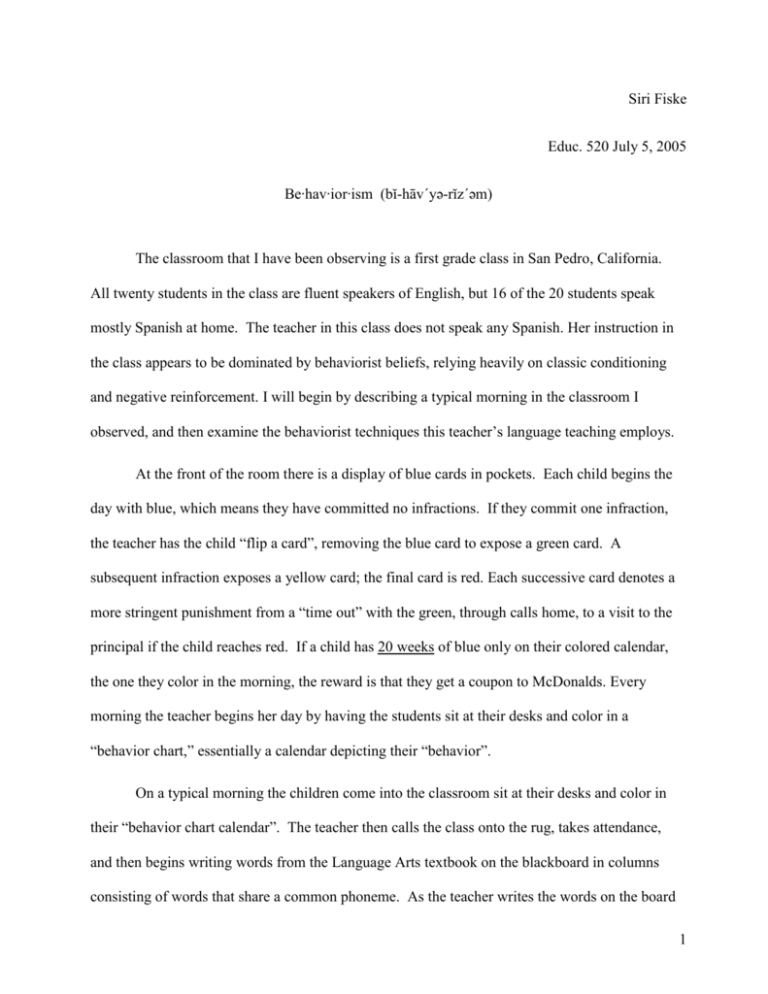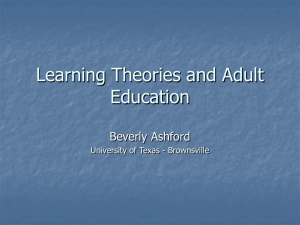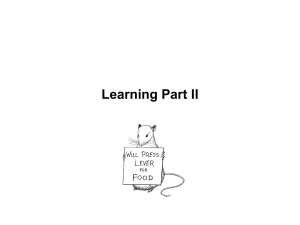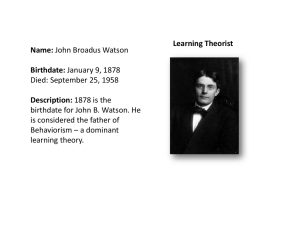The classroom that I have been observing is a first grade class in
advertisement

Siri Fiske Educ. 520 July 5, 2005 Be∙hav∙ior∙ism (bĭ-hāv´yə-rĭz´əm) The classroom that I have been observing is a first grade class in San Pedro, California. All twenty students in the class are fluent speakers of English, but 16 of the 20 students speak mostly Spanish at home. The teacher in this class does not speak any Spanish. Her instruction in the class appears to be dominated by behaviorist beliefs, relying heavily on classic conditioning and negative reinforcement. I will begin by describing a typical morning in the classroom I observed, and then examine the behaviorist techniques this teacher’s language teaching employs. At the front of the room there is a display of blue cards in pockets. Each child begins the day with blue, which means they have committed no infractions. If they commit one infraction, the teacher has the child “flip a card”, removing the blue card to expose a green card. A subsequent infraction exposes a yellow card; the final card is red. Each successive card denotes a more stringent punishment from a “time out” with the green, through calls home, to a visit to the principal if the child reaches red. If a child has 20 weeks of blue only on their colored calendar, the one they color in the morning, the reward is that they get a coupon to McDonalds. Every morning the teacher begins her day by having the students sit at their desks and color in a “behavior chart,” essentially a calendar depicting their “behavior”. On a typical morning the children come into the classroom sit at their desks and color in their “behavior chart calendar”. The teacher then calls the class onto the rug, takes attendance, and then begins writing words from the Language Arts textbook on the blackboard in columns consisting of words that share a common phoneme. As the teacher writes the words on the board 1 she pronounces each phoneme and the class repeats what she says. Then she says “blend” and they all blend the phonemes to pronounce the word. They repeat this about 5 times with each word. Then the teacher calls several children up to the board one at a time to use a wooden pointer to individually point to each phoneme, pronounce it, and then, on command, blend the phonemes to pronounce the complete word. After several children have repeated this they all sit on the rug and the teacher again points out phonemes and blends, with the class echoing. Then she has “girls repeat”, “boys repeat,” “all repeat”. The children respond immediately and even anticipate which particular group she will call next to “echo” her. Then the children move to their desks and get out their reading books. The teacher tells them what page to turn to and they all repeat the page number out loud and open their books to that page. The teacher reads a sentence, says “echo,” and the whole classroom reads the sentence out loud together. The children are required to keep their finger on what ever word is being read at that time. This reading and repeating continues for about a half an hour. They followed precisely this same routine all seven mornings I went to the class. During these two instruction periods, if at any time the teacher deems a child not to be participating or paying attention, she tells the child to “flip a card”. A child who plays with his shoelace during the 40 minutes of sitting on the rug has to flip a card, as does a child who fails to keep her finger on the words that the teacher is reading. Sometimes when the teacher is talking or writing on the blackboard, she may tell a certain child to flip a card if she doesn’t feel they are looking at her. This teacher’s behaviorist framework is obvious. Her reading-pronunciation instruction is Pavlovian classic conditioning (Mora-Flores, June 14, 2005). The teacher provides the stimulus words “echo” or “blend” to condition the children to emit a verbal pronunciation response. More 2 specifically she is using Skinnerian language instruction to shape her students’ behavior. Pavlov did not teach his old dogs new tricks, he simply elicited the dogs’ built-in responses. Skinner showed that conditioning could proceed in small steps so that animals and peoples’ responses could learn new behaviors. This “operant conditioning” indicates that the animals operate on their environment. His animals “learned what to do and when to do it” (Edson, 1975, 41). Skinner’s theory was that children learn language by imitating, repeating whatever utterances are reinforced (Freeman & Freeman, 2004, p.2) In this classroom the children are being taught the spoken language by repeating the teacher. The teacher is not concerned with the students’ thoughts, feelings or motives; rather she is simply shaping their behavior. She conditions the children to look at her, look at the blackboard, repeat with their gender or the whole class, and “blend.” Although alternative views of behavioristic learning based on “positive operant conditioning” have been in vogue for many years, this teacher uses mostly classical conditioning. To understand this in terms of the classroom specifically, we need to look at the work of another behaviorist theorist, Thorndike, who was working around the same time as Skinner. Through experiments with cats, Thorndike showed that animals could do more than just respond to stimuli; their behavior could be shaped by stimuli. Thorndike helped to start a “minor revolution in home and school” (Edson, 1975, p.41) by demonstrating that punishment in the classroom could become counter productive to learning, stifling students’ desire to improve. Along with Skinner, Thorndike established the operant conditioning axiom that rewarding a student’s behavior would cause that behavior to occur again. Operant conditioning is taking place in this classroom when the child deviates from the prescribed responses, either by not repeating the words or by “being distracted”. For example the child playing with his shoelace on the rug, they receive the punishment of having to “flip their card”. In this particular classroom the students are not being rewarded with treats, praise, or other 3 positive reinforcers in their day to day action. The only positive reinforcers are rare and remote, after 20 weeks of keeping “in the blue”. In some ways it is rather ironic that the behaviorist teaching style of this particular teacher is exactly what Skinner and Thordike were trying to change. Skinner criticized the teaching methods of earlier educators that stressed learning to avoid punishment. “The child read numbers, copied numbers, memorized tables, and performed operations upon numbers to escape the threat of the birch rod or cane” (Skinner, 1968, p.15). Skinner also stressed that behavioristic teaching requires consistent and immediate reinforcement (Skinner, 1968, p.17). However, in this particular classroom you might get your card flipped if you touch your shoelace—or you might not, if the teacher doesn’t see you. Receiving a coupon for McDonalds after 20 weeks is so temporally removed that it is not an effective reinforcement for first graders’ good behavior. So, what are these children learning and how are they learning it? At a very fundamental level, the children in this classroom are learning language just by the fact that there is talking. Through oral language, listening and repeating they are learning to make the sounds of words in that particular language, English. In a behaviorist view there is also a general idea that language in general is simply learned by imitation (Freeman and Freeman, 2004, p.2). It is also clear that they are learning how to create the sounds of the words on their own because when the teacher says “blend” the children are creating the sounds of the words, not disjointed phonemes. But we can not see by their behavior alone that they have learned to generalize beyond the specific words they have repeated, because they are not being offered any new words to read, either on the black board lists or at their desks, that the teacher has not modeled. Nor is there any indication that they have any understanding of the meaning of the words they are uttering—or, if they do, how they are learning meanings. 4 Of the seven mornings I observed this routine there was only one instance where the teacher addressed the meaning of a particular word. The children were at their desks repeating her reading of the sentences in a story and following along with their fingers. The teacher looked up to see me taking notes. Perhaps this broke her concentration, or more likely made her selfconscious about her teaching. The sentence they were reading contained the word “apron” (which was not as complex phonetically or conceptually as other words I had observed them reading for several weeks). The teacher asked the children if they knew what an apron was. They were a little startled by her breaking the routine to ask a question and no one responded. She asked again with no response. She then started to describe an apron, saying it was cloth that was used to protect clothes. One child said that he knew what it was: people who brought you food at restaurants wore them, and he described how it tied. The teacher asked for the Spanish word for restaurant attire; no one in the class had any idea. After several further unsuccessful requests, the teacher assigned one of the girls to ask her mother the Spanish word for apron. This one example of her break in this teacher’s routine indicates the deficiencies of behavioristic teaching. The children can imitate, but that does not make them cognizant of what they are saying. If they do not understand what they are reading and saying then what are they learning beyond pronunciation? Brunner critiques behaviorist language instruction very well when he says: In this view’s terms, nothing particularly linguistic needed to be said about language. Language, like any other behavior, could be “explained” as just another set of responses. Its principles and its research paradigms were not derived from the phenomena of language but from “general behavior . . . . Language learning was assumed to be much like, say, nonsense syllable learning, except that it might be aided by imitation, the learner imitating the performance of the model and them being reinforced for correct performance. Its emphasis was on “words” rather than on grammar (Bruner, 1983, p. 32). 5 There have been many criticism of behaviorism (for example, see Myles, 2003, p.66; Brown, 2000, p. 23; Freeman and Freeman, 2004, p. 3). These criticisms range from the ideas stated above to the acknowledgement that children cross culturally develop language in consistent development stages, typically correlated with age and maturation. It also seems that arguments could be made about the validity of using animal behavior to understand human behavior because the possession of language has always been regarded as one of the major differences between humans and other animal . . . no other creatures communicate with spoken language (Jackendoff, 1994, p. 4). To date there does not appear to be one overarching theory of language learning that incorporates everything along the learning spectrum from behavior to thought, from primal instinctive behavioral reactions to uniquely human social interaction. Rather at this point in history it seems the way to understand language learning and learning in general is to combine behaviorism with the other theories of cognition and social interaction. As this classroom shows, narrow adherence to one particular form of teaching and learning, even if the reinforcements are effectively administered, would be limited to shaping behavior and would not foster students to acquire multiple deep layers of understanding. 6 References cited Brown, D.H. (2000). Principles of language learning and teaching. White Plains, N.Y.: Addison Wesley Longman, Inc. Bruner, Jerome. (1983). Child’s talk: learning to use language. New York: W.W. Norton & Company Edson, Lee. (1975). How we learn. New York: Time-Life Books. Freeman, D. E. and Y. S. (2004). Essential linguistics: what you need to know to teach. Portsmouth N.H.: Heinemann. Jackendoff, Ray. (1994). Patterns in the mind: language and human nature. New York: Basic Books. Mora-Flores, E. ( June 14, 2005). Lecture on behaviorism in Educ. 520. USC. Myles, C. (2003). Raising bilingual children. Los Angeles: Parent’s Guide Press. Skinner, B.F. (1968). The technology of teaching. New York: Meredith Corporation. 7









